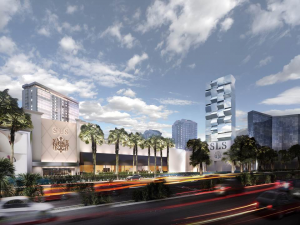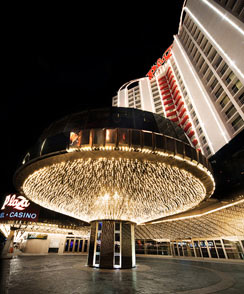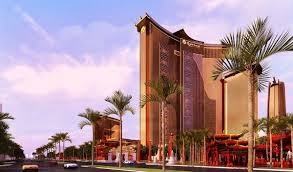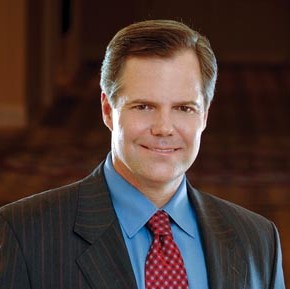SLS Las Vegas is finally doing better, if by “doing better” you mean losing only $39 million in a full 3Q15 as opposed to the $46 million lost in the truncated (five-week) 3Q14. Stockbridge Capital Partners continues to have to prop up Sam Nazarian‘s pipe  dream, paying another $31 million subsidy to the casino. This brings Stockbridge’s underwriting to $59 million for the year. SLS President Scott Kreeger told Howard Stutz that Stockbridge is “committed to the make the property better,” a commitment that comes with a hefty price attached. Nor is Stockbridge demonstrating great business savvy: Why pay to keep the meaningless, equity-less SLS moniker? At least the W rebranding of the Lux Tower is a big, belated step in the right direction.
dream, paying another $31 million subsidy to the casino. This brings Stockbridge’s underwriting to $59 million for the year. SLS President Scott Kreeger told Howard Stutz that Stockbridge is “committed to the make the property better,” a commitment that comes with a hefty price attached. Nor is Stockbridge demonstrating great business savvy: Why pay to keep the meaningless, equity-less SLS moniker? At least the W rebranding of the Lux Tower is a big, belated step in the right direction.
One private-equity firm that’s actually flourishing on the Strip is Blackstone Group, which turned in yet another profitable quarter at The Cosmopolitan of Las Vegas. Even the fire at the Bamboo Pool came up trumps for the Cosmo: The insurance settlement represented 55% of the nearly $5 million profit.
Meanwhile, up at the in-progress Lucky Dragon Casino, owner Andrew Fonfa and CEO William Weidner are playing a game of chicken with the City of Las Vegas. They have the unmitigated gall to demand tax-increment financing from Vegas’ taxpayers (Lucky Dragon sits just inside city limits), threatening to put Lucky Dragon on ice if they don’t get the TIF subsidy. Fonfa and Weidner blame a $25 million shortfall in EB-5 visa funding for the need for public money, adding, “given the uncertainty and extended timeline required to raise EB-5 funds, Lucky Dragon will be forced to cease all development activity in the coming months.”
To put this in perspective, neither Tamares Group nor Derek Stevens came to the city for a handout when they were redoing the  Plaza Hotel or the Golden Gate or The D, respectively. They’ve played by the rules of the free market. However, the city may cave to Fonfa, with City Councilman Bob Coffin being quick to cave. As columnist John L. Smith notes, “there’s a phone book full of local casino resorts large and small that have managed to build and do business in a highly competitive market without receiving handouts from government that divert funds from city parks and programs.” Amen to that. Lucky Dragon is supposed to be the savior of SLS but that seems unlikely to happen if it can’t carry its own freight.
Plaza Hotel or the Golden Gate or The D, respectively. They’ve played by the rules of the free market. However, the city may cave to Fonfa, with City Councilman Bob Coffin being quick to cave. As columnist John L. Smith notes, “there’s a phone book full of local casino resorts large and small that have managed to build and do business in a highly competitive market without receiving handouts from government that divert funds from city parks and programs.” Amen to that. Lucky Dragon is supposed to be the savior of SLS but that seems unlikely to happen if it can’t carry its own freight.
While neither the budding Lucky Dragon or failing SLS makes it into the story, the New York Times has noticed a critical mass of activity on the Las Vegas Strip — everything from MGM Resort International‘s The Park to James Packer‘s Alon. Those of you who follow developments along the Strip won’t find much novelty in the New York Times‘ story, aside from a 13% jump in September room rates, although this is perhaps the first time someone has bundled all the disparate activity into a phenomenon.
“I think capital sources are still being cautious in terms of what projects they’ll lend money to,” warns CBRE Global Gaming  Group veep Michael Parks, and the issue of lower spending by tourists — despite their record numbers — goes begging, although it would certainly explain the caution in the lending sector. Resorts World Las Vegas spokesman Gerald Gardner says “we’re on the edge of what’s probably the most dynamic end of the Strip right now in terms of potential growth,” although that depends on a lot of moving parts outside of Genting Group‘s control — for instance the removal or completion of Fontainebleau and realization of the unlikely to happen All-Debt Arena.
Group veep Michael Parks, and the issue of lower spending by tourists — despite their record numbers — goes begging, although it would certainly explain the caution in the lending sector. Resorts World Las Vegas spokesman Gerald Gardner says “we’re on the edge of what’s probably the most dynamic end of the Strip right now in terms of potential growth,” although that depends on a lot of moving parts outside of Genting Group‘s control — for instance the removal or completion of Fontainebleau and realization of the unlikely to happen All-Debt Arena.
The replacement of the Riviera with an extended Las Vegas Convention Center will be an obvious shot in the arm, but that’s years away, as is Resorts World. “The city is enjoying a stable recovery, and that’s why operating companies familiar with the market are starting to invest,” says Alon President Andrew Pascal, whose project is one of the ones the NYT seems to believe in. (The article holds out little hope for F-blew and Sheldon Adelson‘s St Regis stump).
MGM CEO Jim Murren might still be  able to seize a “visionary” laurel, as the Times cites Caesars Entertainment‘s Linq Promenade and MGM’s The Park as examples of “new urbanism,” a cause near and dear to Murren’s heart. Though MGM prexy William Hornbuckle doesn’t put it in these words, it’s not your father’s Las Vegas: “people enjoy not being constrained in the typical way that gaming used to be. People will find a casino. We don’t have to march you through it or capture you in it.”
able to seize a “visionary” laurel, as the Times cites Caesars Entertainment‘s Linq Promenade and MGM’s The Park as examples of “new urbanism,” a cause near and dear to Murren’s heart. Though MGM prexy William Hornbuckle doesn’t put it in these words, it’s not your father’s Las Vegas: “people enjoy not being constrained in the typical way that gaming used to be. People will find a casino. We don’t have to march you through it or capture you in it.”
‘Bout bloody time!


Glad the Cosmo is dong better, but being profitable these days is much easier than when it had BILLIONS more on its books under DB ownership (appx, $2B more?). Its similar to when people highlight the sudden profitability of Station Casinos.
In the New York Times article the design of The Park looks real good so hopefully when it is complete MGM Resorts International can get a NHL Hockey Team for their new arena and get some big headliners for their new music venue.